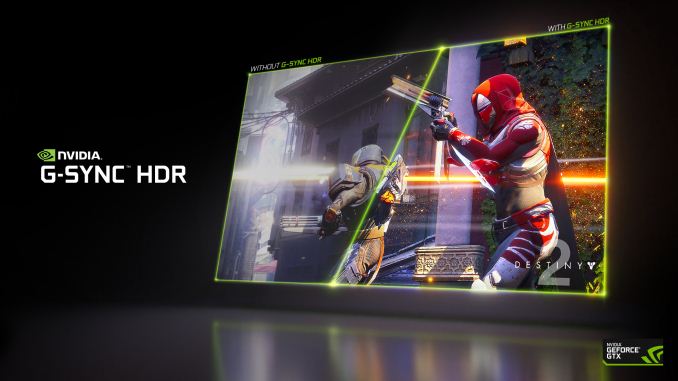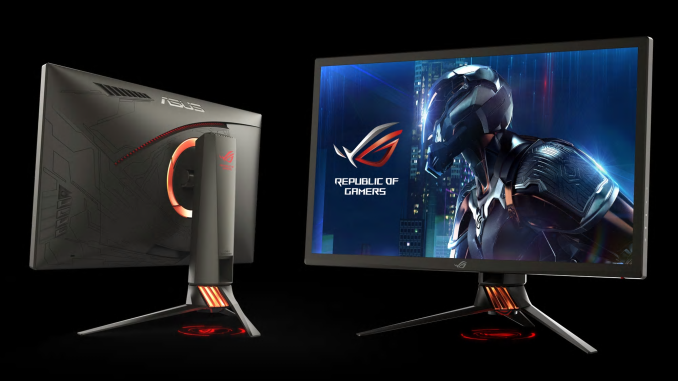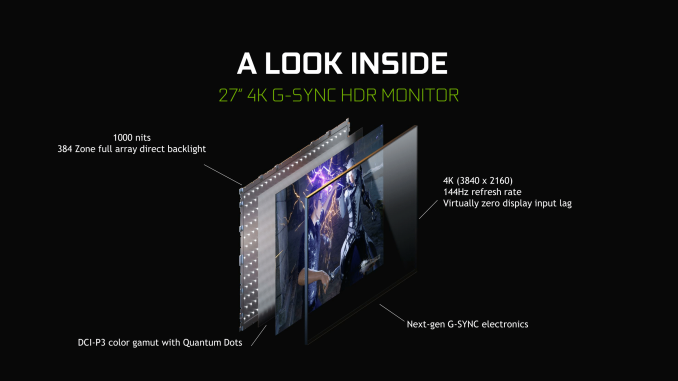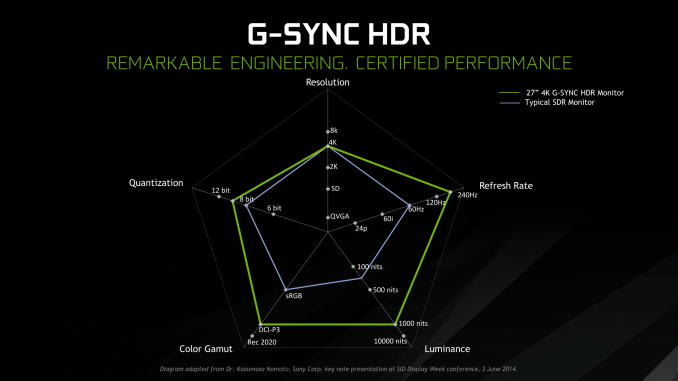NVIDIA Updates on G-Sync HDR: 4Kp144 Monitors On Sale at End of May, Other Models Coming Later This Year
by Nate Oh on May 16, 2018 3:00 PM EST
While NVIDIA's upcoming ultra-premium G-Sync HDR monitors have been in the public eye for some time now, the schedule slips have become something of a sticking point, prompting the company in March to state that 27” 4K 144 Hz models would be shipping and on the market in April. Needless to say, those displays are yet to launch, though preorders for the Acer Predator X27 and ASUS ROG Swift PG27UQ were listed in Europe in mid-April.
Putting some amount of speculation to rest, NVIDIA has indicated the end of May for shipping and e-tail availability of the Acer Predator X27 and ASUS ROG Swift PG27UQ, though ultimately this decision is in the hands of Acer and ASUS. On that note, Acer stated that they had no updates on availability at this time. Both models were first showcased as reference prototypes during CES 2017, and as part of the larger G-Sync HDR lineup, the Predator X27 and PG27UQ will be the first monitors on the market.
| NVIDIA G-SYNC HDR 2018 Monitor Lineup | ||||||||||
| Acer Predator X27 |
ASUS ROG Swift PG27UQ |
Acer Predator X35 |
ASUS ROG Swift PG35VQ |
Acer Predator BFGD |
ASUS ROG Swift PG65 |
HP OMEN X 65 BFGD |
||||
| Panel | 27" IPS-type (AHVA) | 35" VA 1800R curve |
65" VA? | |||||||
| Resolution | 3840 × 2160 | 3440 × 1440 (21:9) | 3840 × 2160 | |||||||
| Pixel Density | 163 PPI | 103 PPI | 68 PPI | |||||||
| Max Refresh Rates | OC Mode |
144Hz (4:2:2 chroma subsampling) |
200Hz | 120Hz | ||||||
| Standard |
120Hz (4:4:4 chroma subsampling) |
Unknown | Unknown | |||||||
| Over HDMI |
60Hz | 60Hz | 60Hz | |||||||
| Variable Refresh | NVIDIA G-Sync HDR Scaler/Module | NVIDIA G-Sync HDR Scaler/Module | NVIDIA G-Sync HDR Scaler/Module | |||||||
| Response Time | 4 ms | 4 ms? | Unknown | |||||||
| Brightness | 1000 cd/m² | 1000 cd/m² | 1000 cd/m² | |||||||
| Contrast | Unknown | Unknown | Unknown | |||||||
| Backlighting | FALD (384 zones) | FALD (512 zones) | FALD | |||||||
| Quantum Dot | Yes | Yes | Yes | |||||||
| HDR Standard | HDR10 Support | HDR10 Support | HDR10 Support | |||||||
| Color Gamut | DCI-P3 | DCI-P3 | DCI-P3 | |||||||
| Inputs | 2 × DisplayPort 1.4 1 × HDMI 2.0 |
DisplayPort 1.4 HDMI 2.0 |
DisplayPort 1.4 HDMI 2.0 Ethernet |
|||||||
| Price | TBA | TBA | TBA | |||||||
| Availability | May/June 2018 | Q4 2018? | Summer 2018? | Fall 2018 | ||||||
NVIDIA did not mention the comparable 27" and 35" AOC models (AGON AG273UG, AGON AG353UCG) were not mentioned but are presumably operating on a similar release timeline. There was also no mention of Acer's Predator XB272-HDR.
While the 27” 4K 144 Hz models were originally slated for a late 2017 launch, Acer and ASUS made a surprising announcement last August on delaying their G-Sync HDR flagships to Q1 2018. Even with NVIDIA’s current end-of-May assessment, ASUS remarked offhand that a June launch was more likely, as firmware and other development work was still ongoing. Not that those were the only G-Sync HDR displays announced – at Computex 2017, Acer and ASUS unveiled 35” curved ultrawide 200 Hz G-Sync HDR displays originally for a Q4 2017 release. Meanwhile, at CES 2018 NVIDIA had already pushed forward with revealing 65-inch smart TV esque G-Sync HDR monitors with integrated SHIELDs, dubbing them “Big Format Gaming Displays” (BFGDs). No update was provided on the schedule for the 35” and BFGDs, only that they were due to come later this year.
Despite the launch on the horizon, full specifications and pricing have yet to be published. The features and specifications remain the same as we have known earlier: utilizing AU Optronics’ M270QAN02.2 AHVA panel, the 27” G-Sync HDR monitors bring 3840×2160 resolutions with up to 144 Hz refresh rate (at half chroma) and quantum dot film, and offering DCI-P3 color gamut and HDR10 support, a peak brightness of 1000 nits brightness, and full array local dimming (FALD) functionality with a 384 zone direct LED backlighting system. On top of that, Acer and ASUS include their own monitor features and OSDs; for the actively cooled ROG Swift PG27UQ, this includes Tobii eye-tracking and ultra-low motion blur (ULMB).
For the few refresh rate asterisks, the amount of bandwidth needed for HDR at 10-bit 4Kp144 with 4:4:4 chroma subsampling exceeds DisplayPort 1.4's capability, and so setting the refresh rate above 98 Hz will have the monitor drop to 4:2:2 chroma and use dithering with 8bit and frame rate control (FRC). Though this bandwidth bottleneck is largely out of ASUS/Acer and NVIDIA’s hands, with DisplayPort 1.5 and even HDMI 2.1 very much too new to be incorporated in these models.
That being said, a straight conversion of European preorder prices sans VAT puts the price range at $2500 to $3000, though this does not directly implicate US pricing. As G-Sync HDR flagship gaming monitors, they have essentially every feature of ultra-high-end consumer/gaming monitors. But additionally, the AU Optronics AHVA panel is pricier as it is only purchased as combined LCD and backlight unit, and with the cost of the upgraded G-Sync HDR scaler and module, adds a cost premium that is passed onto consumers.
Ultimately, the HDR situation itself is also a little murky. Outside of HDR10 support, NVIDIA’s G-Sync HDR certification mandates and requirements are kept between them and the manufacturers, and so the specific dynamic range of G-Sync HDR isn’t clear. Presumably there are quantized public guidelines with minimum peak brightness, localized dimming capability, minimum percentage coverage of DCI-P3 gamut, and the like. In other words, much like VESA’s open DisplayHDR 400, 600, and 1000 standards that are both directly linked to numerical performance metrics but also can be independently verified by consumers themselves with VESA’s open test tools and test benchmarks.
At the time, NVIDIA did not express any standardized HDR specifications outside of their G-Sync HDR certification process, reiterating that G-Sync HDR represented a premium gaming experience and expecting OEMs and monitor manufacturers to list any HDR specs relevant to their models. In any case, these 27” monitors adhere and thus carry the UHD Alliance’s Ultra HD Premium logo, which is 4K specific. For the publicly-announced G-Sync HDR displays, it appears that only three types of AU Optronics panels are involved, and so capabilities and featuresets will naturally align closely. NVIDIA also stated that G-Sync HDR had no particular focus on Windows HDR support.
As HDR monitors are a burgeoning market segment, NVIDIA brought up the need for consumer education on the wide spectrum of HDR performance. For consumers looking for a high-end variable refresh rate monitor with HDR, an HDR brand not strictly attached to performance parameters isn’t quite as elucidating as "4K", "IPS", "144 Hz refresh rate", or "4ms response time". As new panel technologies are developed and mature, it will be interesting to see how these changes would be conveyed through the “G-Sync HDR” brand.
Source: NVIDIA




















46 Comments
View All Comments
beisat - Wednesday, May 16, 2018 - link
Generally cool, I am quiet interested in a BFGD display, but no HDMI 2.1 is a no-go for me, as I would use it for my main living room screen and at latest when a PS5 arrives sometime in 2021 I would be annoyed of not having full RGB 4:4:4 with my HDR.Sivar - Wednesday, May 16, 2018 - link
The next best thing is always coming in a few years. HDMI 2.1 products are on that list, but by then there will be an announcement for another. The future is bright and exciting, but we can only buy that which is available in the present. :)beisat - Wednesday, May 16, 2018 - link
Generally agree, but here we are not talking about products which can do more, just a connector. I guess this is just what is so annoying for me - the product can do everything, but the silly connector and cable cannot get the data over fast enough. Similar to 4k with 30fps HDMI 1.4 - it's just not a balanced product somehow.Fallen Kell - Wednesday, May 16, 2018 - link
Exactly. The panels are fully capable of running at 4:4:4 120hz (or above), the problem is that there is no interface to feed them at that bandwidth. It is also possible that some of the internal controller busses might not support that bandwidth either since they knew that there was no connection interface that could provide it.But this is one of those cases where they should have simply waited to use HDMI 2.1. With them already delaying these monitors until now, which is 8 months after HDMI 2.1 was official, they should have been looking at a redesigned controller to handle the new HDMI standard which would have unlock the full potential of the panels. People have already been expecting to see the first batch of devices implementing HDMI 2.1 release in the next few months. With those knowns, and the fact that this is such a high end panel targeting a specific consumer base (which happens to know and follow the fact that these panels are gimped out of the door without having HDMI 2.1), these companies shouldn't expect very good sales. I know for a fact that I won't buy one if it does not have HDMI 2.1...
cmdrdredd - Wednesday, May 16, 2018 - link
Actually from what I hear consumer displays with HDMI 2.1 won't make it to retail for a couple years yet.rtho782 - Thursday, May 17, 2018 - link
Why they didn't just make you use two DP cables (as 4k monitors used to) I don't know. Then they could hit 120hz 4:4:4.I have completely lost interest in this product now.
professional - Thursday, May 17, 2018 - link
this is utterly stupid. don't expect the next PS will cover 4K-144Hz.. it won't.+ you have two display ports, so you will be able to use both at the same time which is exactly the same than having more bandwidth than display port 1.5 or hdmi 2.1 .
+ There is not game that can run in 4k-144hz with hdr and chroma 100% (only older game not AAA can run at theses specs, and they weren't made in HDR neither 8bits+ color.
Ahnilated - Sunday, May 20, 2018 - link
You mean, there is no Video card that can.Glenwing - Saturday, May 19, 2018 - link
It's not really "just a connector" we are waiting for.The capability to signal at those speeds comes from the chip generating the signals, not from the physical port. We are waiting for the next generation of HDMI control chips that can signal at 12 GHz per channel as opposed to HDMI 2.0 chips which only needed to signal at 6 GHz per channel. It's no simple feat to create these systems and bring them to mass production. It really isn't so different from waiting for the next generation of GPUs and CPUs after all.In addition, I should point out that the publication of the HDMI 2.1 specification doesn't mean "products will be coming out any time now"; that's when the designs for new products BEGINS, and it takes a lot longer than 6 months to get these things rolling. At the current moment, the HDMI 2.1 CTS (compliance testing specification) isn't even finished yet, so it would be impossible to for any HDMI 2.1 device to be available, as the HDMI creators haven't even finished writing the testing procedures for HDMI 2.1 (we expect it to be finished in late 2018). Don't expect HDMI 2.1 products for at least a year at minimum. Development cycles for new interfaces are very long from the time the specification is first published.
Ikefu - Wednesday, May 16, 2018 - link
I still think the price premium for G-Sync is stupid when Freesync is a thing and royalty free. Seems like it would be easy for them to add so I can have a better choice in monitors for my 1070. This is a straight up money grab for NVidia. Is there really any benefit to G-Sync over Freesync 2 in terms of performance?